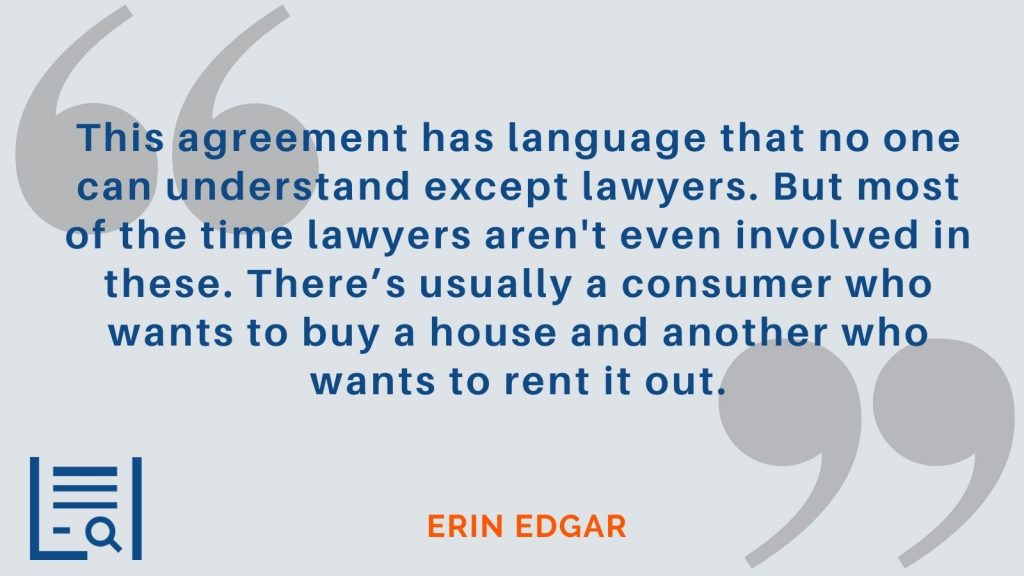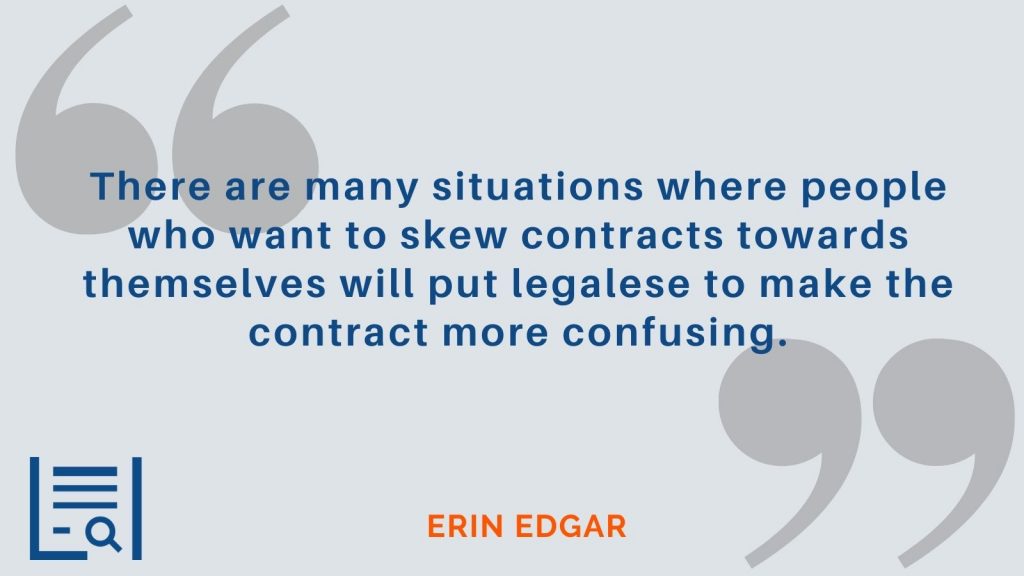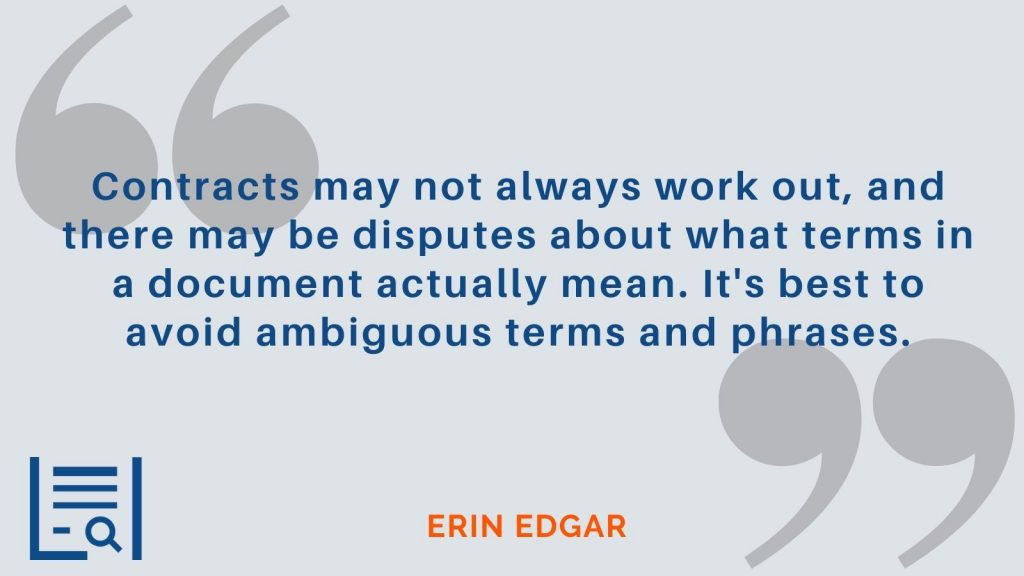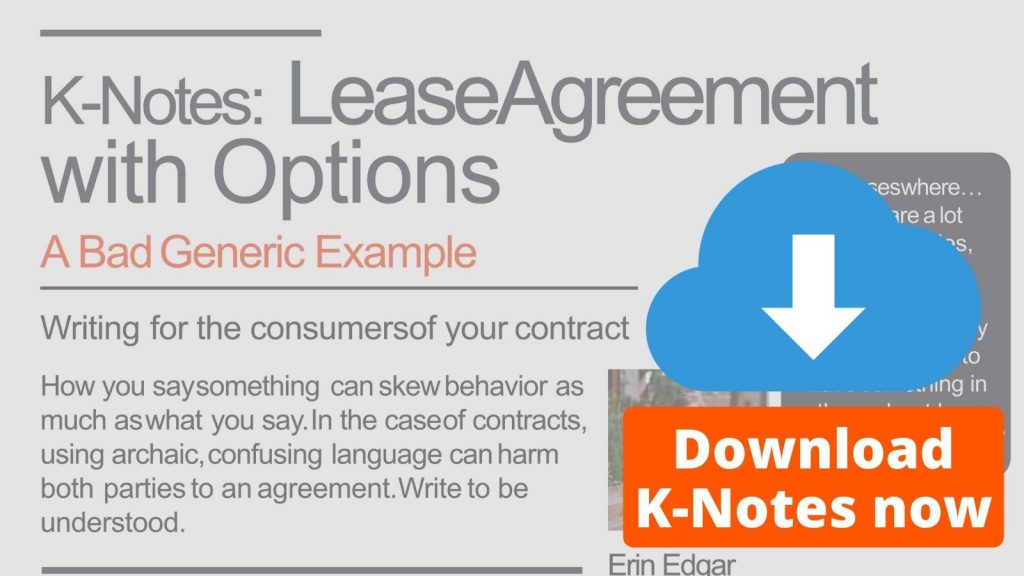As we review a lease agreement with an option to purchase real estate with Erin Edgar, we notice that certain documents are written ineffectively to make it difficult for the other side to exercise their rights. Erin Edgar, who has worked in non-profits for many years and has transitioned to estate planning, delves into a landlord-friendly agreement that is lacking in details, has ambiguous language, and is riddled with legalese. She discusses both what consumers can do at their end and what drafters need to take note of when representing consumers.
Questions in this Episode
- What are the repercussions of omitting details while drafting agreements?
- How can you avoid ambiguity in a document?
- What is the importance of a resolution mechanism?
- How can consumers access user-friendly documents?
- What should drafters take note of when working with such documents?

Brief Overview
These agreements are drafted when people wish to flip houses. This is especially attractive to those who may not be able to afford a house but dream of having one. Purchasers promise to pay rent to the landlord for a fixed period of time and agree to exercise their option of buying the property at a later date. The landlord promises a clear title that is free of encumbrances and offers all further assurances.
When the time comes to exercise the option, the tenants frequently lack the funds to do so. People believe they will be able to afford it later, but the more usual situation is that the landlord will not exercise the option or will give the purchaser rubbish as if the time has passed, or would entirely deny having an option in the first place. The landlords also end up placing conditions on the option, such as requiring it to be exercised within a certain time frame creating an extra burden for the purchaser.

Lease agreements are often, as this one is, geared towards the landlord. - Erin Edgar #ContractTeardown Click To Tweet
Avoid Clumsy Structure and Don’t Omit the Details
The definitions section is completely missing from this agreement. This agreement requires one because it has terminology like lease, options, fee simple absolute, and a lot of obscure words that need to be clearly defined. This is one of the most prevalent contract ambiguities.
Section 2 addresses the term of the option and then all of a sudden 2(A) discusses exit agreement. It discusses assignments that have no connection with the term of the option. It would be more logical to have 2(A) be 10(A) because that refers to the assignment of the option.
|
Section 7 outlines what happens if the tenants violate the terms of the lease. It states that if the tenant is unable to perform any of the “covenants,” which is again, vague and should be defined. It also has this language: “it shall be lawful for the Landlord/Seller to enter into the said property… and enjoy the same as if this Lease/Option had not been made…” and it keeps going on and on. This language has no connection with the breach of contract.
| BREACH BY TENANT/BUYER: If the Tenant/Buyer shall fail to keep and perform any of the covenants, agreements, or provisions of this Lease/Option, or If the Tenant/Buyer shall abandon the property; it shall be lawful for the Landlord/Seller to enter into said property and again have, repossess, and enjoy the same as if this Lease/Option had not been made, and thereupon this Lease/Option and everything herein contained on the part of the Landlord/Seller to be done and performed shall cease, determine and be utterly void, except as set forth in paragraph (8), below. The commencement of a proceeding or suit in forcible entry and detainer or in ejectment, or otherwise after any default by the Tenant/Buyer, shall be equivalent in every respect to actual entry by the Landlord/Seller. |
Section 7 contains no safeguards for the tenant. For example, if the landlord says, “Sorry, I’m not going to sell it.” What happens next? The contract makes no mention of this. It does not protect the tenant in enforcing any compensation for breach or determining what constitutes a breach against the landlord. It’s an entirely one-sided provision. If a tenant can breach the lease, so can a landlord. Work with that mindset.
Avoid the Legalese
This document isn’t written for consumers and has so much legalese that it’s almost non-functional for a consumer.

In this contract, some words don’t even matter. Section 3 for example contains the words “hereunder,” section 5 has “hereby,” “heretofore” and there are too many ‘here-’ words that don’t seem to make sense at all.
|
RENT: Tenant/Buyer agrees to pay to the Landlord/Seller, the sum of $ _____ per month, with the first payment beginning as rent for the property, for the term of this Lease/Option, and during any extensions thereof. All rental payments shall be due and payable in advance on the 10th day of each and every month. An amount equal to $____for each month in which rent was paid, shall be credited to the Tenant/Buyer and applied to the purchase price of the property in the event that the Tenant/Buyer exercises its option hereunder; otherwise, this credit shall be non-refundable and considered forfeited if the option is not exercised. COVENANTS OF TENANT/BUYER: Commencing with and during the term of this agreement, including extensions, the Tenant/Buyer hereby covenants and agrees as follows: That the Tenant/Buyer will pay all utility charges and bills, including, but not limited to, water, sewer, gas, oil, and electric, which may be assessed or charged against the property; That the Tenant/Buyer will not use the property for any unlawful purpose; and that the Tenant/Buyer will conform to and obey all laws, ordinances, rules, regulations, requirements and orders of all Federal, Stale, and Local governmental authorities, agencies, departments, bureaus, boards or officials, respecting the use of the property; and That the Tenant/Buyer will surrender and deliver up the property, at the end of the term or any extensions thereof, should the option herein not be exercised, in as good order and condition as the same now exists, reasonable use and natural wear and tear excepted. |
Section 13 talks about “monies” that will be exchanged between the Parries. What exactly are “monies”? Why can’t it just be written as money? This simple change reduces so much legalese and avoids a mess.
There is now a movement in law and legal writing called the plain writing movement. Remove the legalese and focus on functionality.
Contracts should be written in a way that people can understand what they are agreeing to. - Erin Edgar #ContractTeardown Click To Tweet
Don’t Forget a Resolution Mechanism
A lack of a dispute resolution process, like that found in this contract, is a risky situation for both parties. It is unclear what will happen if things don’t work out or how conflicts would be resolved. It is critical to ask the following two questions:
- Will the parties use mediation, arbitration, or the courts?
- What are each party’s rights when it comes to resolving a dispute?
With such agreements, consumers will have to go to court from the start, and the venue, choice of law, and other fundamental elements of a contract will be contested because they were not included in the contract by the drafter. The consumer would be expected to pay for all motions and rulings only to get to the stage where they could prove the contract’s validity. Contracts are sometimes designed to be non-functional for the purchaser or consumer, making it difficult to prove the validity or enforce any rights in court.
The tenant is left with the feeling that they have not been treated fairly; they want the money back that they paid as rent, and because the contract does not specify how to get to court or what to do in a dispute situation, the tenant is left thinking they have no recourse. And the landlord takes advantage of the tenant’s lack of alternatives.

How to Find a Usable Document?
In case of the absence of a resolution mechanism, either party would be burdened with the cost of filing in the appropriate court and state. The issue is that parties are unsure of what to do or where to go. They have to find an attorney and pay a massive amount of money to get help and if they cannot afford it, as is often the case with tenants, they end up quitting. The buyer is neither powerful nor well-funded.
As an attorney, it’s your job to prepare a contract that is free of ambiguities while keeping in mind the potential pitfalls that your client may face down the line. With such robust contracts, consumers can avoid all the potential ambiguities, conflicts, and negative practical implications for getting a cut-and-paste contract from the internet.

Drafting Note
Make sure to stay away from documents and schemes like these. When you’re representing a customer, tell them why it’s important to have a solid contract with clauses that protect their rights. Give them instances from previous cases that have ended up in courts and involved far more problems and funds to deal with.
Define terms, use consumer-friendly language, provide adequate protection in event of a breach, be explicit, and don’t forget to include a reliable dispute resolution process.
Step in the shoes of a consumer and save them time, effort, and money by giving appropriate advice and protection through the use of relevant drafting language.
In this episode of Contract Teardown from Law Insider, Attorney Erin Edgar tears down a really, really bad lease agreement with option to purchase real estate. I mean it’s bad. So let’s tear it down!
THE CONTRACT: https://www.lawinsider.com/contracts/1jjr0MqLWZS#
THE GUEST: Erin Edgar, upon becoming an attorney, I discovered a deep empathy for children and a wish to protect children and serve their interests to ensure, as far as I am able, that they are allowed to thrive and grow.
I received such things from my parents, but there are children who do not have parents as keystones in their lives, whether due to divorce or death. It becomes especially important for parents to develop plans to ensure that their children are protected if parents should divorce or the parents are no longer able to act on their children’s behalf. I also help parents craft legacy plans for families with children in mind. These plans not only create a will to ensure that children will inherit monetary wealth from their parents but also include measures to protect the children until a will is probated and also material that teaches their children the parents’ values and spiritual wealth.
THE HOST: Mike Whelan is the author of Lawyer Forward: Finding Your Place in the Future of Law and host of the Lawyer Forward community. Learn more about his work for attorneys at www.lawyerforward.com.
If you are interested in being a guest on Contract Teardown, please email us at community@lawinsider.com.


